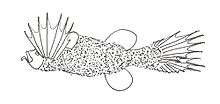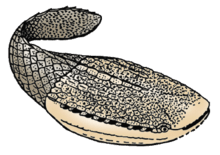Mirapinna esau
Mirapinna esau, the hairyfish, is a species of flabby whalefish only known from the Atlantic Ocean from near the Azores. Formerly considered a member of the no-longer-recognized family Mirapinnidae, this species is the only known member of its genus.
| Mirapinna esau | |
|---|---|
 | |
Not evaluated (IUCN 3.1) | |
| Scientific classification | |
| Kingdom: | |
| Phylum: | |
| Class: | |
| Order: | |
| Family: | |
| Genus: | Mirapinna Bertelsen & N. B. Marshall, 1956 |
| Species: | M. esau |
| Binomial name | |
| Mirapinna esau Bertelsen & N. B. Marshall, 1956 | |
Description
Mirapinna esau grows to a length of 5.5 centimetres (2.2 in) total length (TL). Little is known of the fish beyond its appearance. Wheeler (1977) states that only one specimen was caught, near the sea surface, and that it was a copepod feeder.[1][2] The original specimen was captured north of the Azores at 47°20'North, 22°30'West.[3]
Etymology
The generic name is from the Latin mirus (wonderful) and pinna (thorn), for the unusual fins possessed by this fish.[4] The specific name is from the Biblical figure Esau, who is stated to be a hairy man (Genesis 27:11).[5]
References
- "Hairyfish - Mirapinna esau - Details - Encyclopedia of Life". Encyclopedia of Life. Retrieved 5 May 2014.
- Wheeler, A. (1977). Das Grosse Buch der Fische. Stuttgart: Eugen Ulmer. p. 356.
- Froese, Rainer and Pauly, Daniel, eds. (2012). "Mirapinna esau" in FishBase. August 2012 version. Retrieved 5 May 2014.
- "Mirapinna esau". Discover Life. Retrieved 5 May 2014. based on Romero, P. 2002, Madrid, unpublished.
- Isaak, Mark. "Curiosities of Biological Nomenclature: Etymology: Names from Mythology". Retrieved 5 May 2014.

